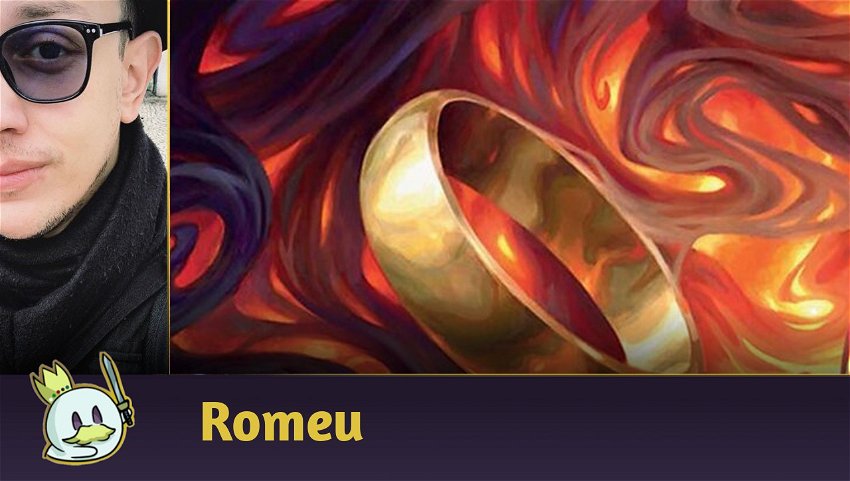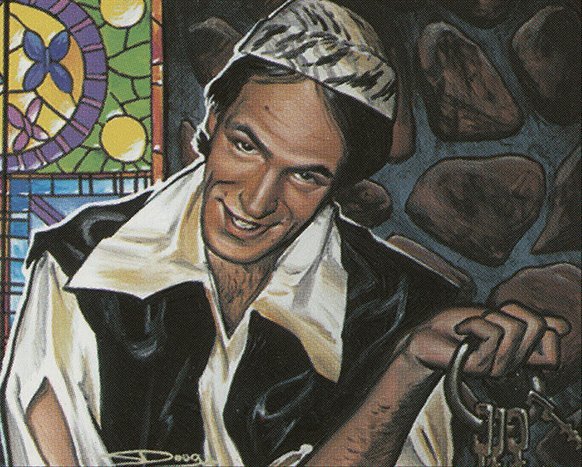Lord of the Rings: Tales of Middle-Earth is probably the most anticipated release for Magic: The Gathering in 2023. The set is part of the Universes Beyond series, which depicts lore and iconic characters from other franchises on cards, as has happened with franchises like Street Fighter, Warhammer 40,000, Arcane, The Walking Dead and Fortnite.
Unlike most of these products, Tales of the Middle Earth will be a booster set, meaning it will follow the pattern of what we see for the Standard or Masters Sets that come out every year. However, its cards will be Modern-legal, in addition to Legacy, Pauper and Commander, which gave it the pseudo-fame of possible Modern Horizons 3, who could impact the competitive universe of these formats and change them forever. Its release date is scheduled for June 23.
Ad

The first wave of official previews began yesterday through an article by IGN, which revealed one of the most important elements of J. R. R. Tolkien's book series, The One Ring. And today, we'll look at the potential of this iconic artifact in Modern and Legacy.
The One Ring: Review
The One Ring brings a unique effect at an appropriate cost.
In its 30 years and over twenty thousand different cards released, Magic: the Gathering only has five cards that include the phrase Protection from Everything in their text, with the sixth being The Ring.
Once it grants this effect to its controller, they can't be targeted by spells or abilities, all damage that would be dealt to them is prevented, and Auras can't be attached to them. However, there are a few caveats: effects that say damage can't be prevented still allow damage if its source doesn't target players, asymmetric effects that say "each player" still affect the Ring's controller, and having Protection from Everything doesn't prevent the opponent from winning the game through non-traditional means (such as Thassa's Oracle or Nicol Bolas, Dragon God's ultimate).
The Ring's second ability is a value engine: it immediately gives you an extra draw the turn you cast it, and since you have protection from everything, it will give you two more draws the next turn, making a total of three draws and a pseudo extra-turn for only four mana. This makes the artifact an excellent value engine for attrition matchups, as it generates immediate value that builds up on a recurring basis as the turns pass, but at the cost of losing a high amount of life if the game drags for too long.
It is an excellent attrition tool that offers you more features for a price that becomes steep in the medium term. In terms of flavor, Wizards has nailed the way to represent The One Ring in Magic, and just as characters from Middle Earth are tempted by its powers, players definitely won't be able to resist the temptation to discover combos that abuse its effects - like in Commander, where It was combined with Mind Over Matter for infinite draw (and then winning the game with Thassa's Oracle).
In a general context, The One Ring does a lot for a relatively low cost for all its qualities, and while its natural home would be against card advantage-oriented games, its true potential lies in the various interactions with other cards that allow for looping, or with strategies that can easily benefit from a pseudo-Ancestral Recall with Time Walk for four mana, since you are granted one more turn due to protection and three more cards in hand between the artifact's two activations.
The One Ring and Modern
It's not hard to conclude that The Ring has some best friends in Modern, including those known for enabling some absurd interactions in the format.

The first and main piece of interaction with The One Ring in Modern goes through Emry, Lurker of the Loch, as the artifact needs to be cast to grant protection to its controller. Therefore, effects like blink or reanimate don't work to abuse this ability, and since Emry lets you cast an artifact from your graveyard, she will always ensure you get the most out of the Ring each turn while enabling a lock against the opponent if they have no answers or other means of winning the game that doesn't involve combat.
Ad
And to put The One Ring into your graveyard, there's no shortage of options either:

Out of those, Grinding Station is probably the safest route since there's already a combo with it alongside Underworld Breach, and with the Ring, you can mill three of your opponent's cards for every turn they fail to handle the looping, creating a consistent wincondition with few parts.
Thopter Foundry is another interesting artifact to play alongside The One Ring, as it also speeds up your wincondition and interacts well with another well-known combo in Modern with Sword of the Meek and Urza, Lord High Artificer.
However, although as you have Protection from Everything, your permanents are still amenable to interaction. Therefore, focusing on a plan that involves relying too heavily on Emry, Lurker of the Loch to close a recurring loop can be a major challenge in a format where cheap removals like Lightning Bolt, Unholy Heat and Solitude are common in the competitive scene.

Decks featuring Karn, the Great Creator are mostly Big Mana archetypes like Tron and Mono Black Coffers since the release of Modern Horizons II. And although he doesn't establish loops with The One Ring, granting access to the artifact at any point in the game can become a decisive element in several games. So, you can expect to find it as at least a one-of on the Sideboard of these archetypes.
And if you have plenty of mana and want to loop, there are a few options:

The Mycosynth Gardens has seen play on Amulet Titan, but can be used to copy The One Ring and force its controller to sacrifice the original Ring every time it comes into play due to the Legends Rule, thus putting it in your graveyard to be returned to your deck with Academy Ruins at your Upkeep.
Loopings with Academy Ruins are common in Mono Blue Tron due to its interaction with Mindslaver, and although this artifact is more efficient at crashing the opponent's game, it also requires a much higher amount of mana, and since the list naturally runs Karn, the Great Creator, the option to include another artifact to close the combo, such as Grinding Station, to sacrifice The One Ring and return it to the top of the deck is a valid approach whose potential should be considered.

If we look at the Ring as a value engine, it finds another excellent companion in Teferi, Time Raveler, which is present in a considerable majority of Modern decks that abuse three or more colors to establish an efficient attrition plan. Whether with Elementals, Valakut, the Molten Pinnacle or classic Goodstuff shells, there's plenty of room for lists that support Teferi as a means of extracting value, and they could easily benefit from the massive amount of card advantage that The One Ring offers next to the Planeswalker.
Ad
Also, in formats like Modern, "wasting" a turn or winning a turn can be the crucial difference between victory or defeat. If your opponent has closed a combo that will make you lose the game on the next turn, The One Ring will offer you three cards and one more opportunity to survive and/or close your combo before they can deal lethal damage to you. If by chance they created an irreversible board state, The Ring will also guarantee you the necessary means to try to turn the game around or even win, and if you find another copy of it, you can play it and guarantee more draws and one more turn to find an answer.
In general, The One Ring doesn't feel like an instant staple to every deck in Modern, but it does a lot for its cost and might manage to find a home in a wide variety of archetypes, be they combos, Blue -Based Control or the famous Goodstuff Decks, not counting the possibility of running them on Midranges that can efficiently take advantage of their effect without being too late by paying four mana in the process.
The One Ring and Legacy

The combo that has generated debate in Commander also exists in Legacy. There, you tap The One Ring to add a counter and draw one or more cards, then discard a card to untap it with Mind Over Matter and repeat the process until you have no more cards in the deck and proceed to win the game with Laboratory Maniac or Thassa's Oracle. However, five mana is already too high a cost without Cloudpost or Sol Lands, and at four blue mana, it's virtually uncastable in the format.

Emry also exists in Legacy and sees a lot of play on archetypes like 8-Cast and Painter Stone. Therefore, supporting The Ring on these archetypes would be a viable option if they weren't so mana intensive, as 8-Cast wants a high number of low-cost artifacts to cast Kappa Cannoneer early, while Painter Stone has a more efficient and immediate combo.
In addition, it has the clause of only offering protection in the cast, which means it also doesn't interact with Goblin Welder and similar effects.

The next option for The One Ring in Legacy would be Stompy strategies: Mono Red Prison, Eldrazi and Initiative are examples that come to mind, as in addition to being able to support a solid base that doesn't rely on cheap artifacts to play their winconditions, they can also lock the opponent and enjoy the benefits of two or even three activations of the Ring before it becomes a problem - and if it does, options like Breya's Apprentice can help mitigate this damage.
Speaking of Initiative, The Ring is quite problematic alongside this mechanic, as it is an asymmetrical effect that your opponent cannot interact with. Therefore, its inclusion in Legacy could lead to the archetype finding new paths after the recent ban on White Plume Adventurer.
Ad

Another place where the artifact can draw attention as a sideboard or even maindeck piece is in Storm decks, as they can take advantage of the artifact's draws, and its strategy interacts incredibly well with the Protection from Everything function, since that means not having to worry about Thoughtseize or Xantid Swarm (although it's no longer the anti-Storm staple it once was).

Finally, The Ring deserves some attention and testing in the various Control variants, as these archetypes are also the ones that don't usually mind tapping out to cast four-mana Planeswalkers like Jace, the Mind Sculptor and The Wandering Emperor. Of course, the artifact doesn't pitch to Force of Will and that makes a huge difference, but there are occasions in Legacy where having access to it in your Maindeck or Sideboard can be helpful, and its cumulative card advantage can also be mitigated by Teferi, Time Raveler in the format.
Conclusion
The One Ring offers a unique effect so powerful that it can be compared to the combination of two of the most powerful cards in Magic: The Gathering, albeit at a higher cost compared to both. In eternal formats, it has some possible interactions with other cards or strategies, but its sheer value already makes it good enough to be considered in the Maindeck or Sideboard of a variety of archetypes.
If this first preview proves anything for players, it's that Tales of the Middle Earth will indeed have a power level on par with what we've come to expect from a Modern-oriented set, and among a variety of cards that will be considered for casual, we can also expect some strong enough pieces which might become competitive staples.
Thanks for reading!







— Comments0
Be the first to comment